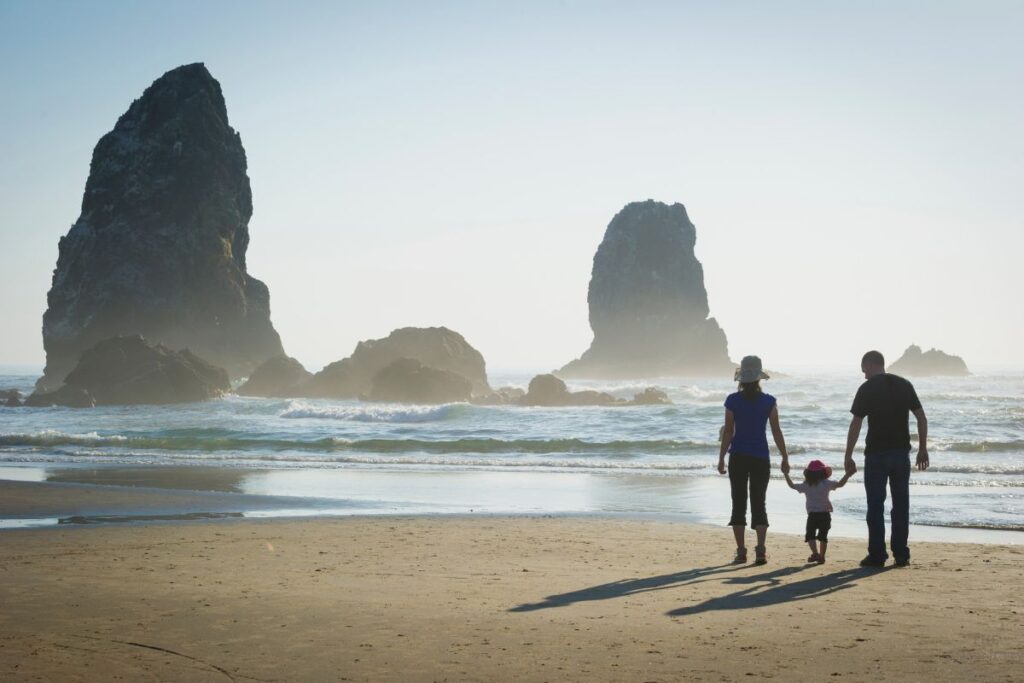Inside: Learn four ways to adopt a simpler lifestyle with family minimalism.
A guest post from Katie Brenneman
Raising a family today can definitely be stressful and anxiety-inducing. Some of the reasons for this might feel out of your control at times.
However, there are some changes you can make to your family’s lifestyle that have a positive influence on everyone involved.
One way to approach this is by adopting a simpler way of living through family minimalism. More families are discovering there’s a sense of joy that can come from this intentional approach to life.
They tend to find that they’re less focused on the material one-upmanship that’s so common today. Not to mention that their way of life is a little less costly and a little more conducive to positive family experiences.
Family minimalism isn’t always easy, though. So, how can you get started with a simpler lifestyle? Here are a few ways.

Family Minimalism: 4 Ways to Adopt a Simpler Lifestyle
If you’re interested in pursuing family minimalism, consider these four ways of adopting a simpler lifestyle.
1. Consider Downsizing
One of the key things some families are doing to commit to minimalism is downsizing their homes. This can feel strange. Let’s face it, it’s more common in today’s society to embrace the idea that bigger is better.
However, when it comes to homes, bigger can also mean a more complex and expensive way of life. Living with more space than you need leads to more time cleaning and organizing. You’re also likely to pay higher bills to heat, cool, and light your big house.
Some families have chosen to invest in tiny homes. These properties are usually no larger than 600 square feet.
This might seem like an extreme approach, but it can also lead families to be more creative about how to use their space. Not to mention it forces them to reduce their unnecessary material belongings because there simply isn’t space for them.
However, if the tiny home movement isn’t quite for you, you can still downsize effectively. Take the time to assess the essential number of rooms and the size of outdoor space your family genuinely needs. You can then base your new home search around meeting this rather than exceeding it.

2. Declutter Regularly
If you decide to buy or rent a new and smaller home, you’ll need to adopt an effective decluttering process in time for your move. After all, parting with your belongings in a healthy way can reduce the number of items to transport. It also minimizes unnecessary clutter in your new space.
Start by making a list of the essential items to take with you. From here you can consider the available area in your new home.
Perhaps try to envision yourself as a visitor to your house so you can understand which objects might be making your house look cluttered. From here you can dispose of and donate the things that aren’t serving your family.
This brings us to another way to practice family minimalism. Don’t limit your decluttering to your move. Instead, make identifying and removing visual clutter a regular part of your routine.
This can certainly lower the stress that can come from being surrounded by constant mess. Encourage each member of your family to take a moment and a room each week to examine for obvious clutter.
Assess the clutter as to whether it’s essential — such as bills or personal belongings — and tidy it away accordingly. Whereas unneeded clutter can be taken to a designated area for collective recycling, donating, or selling.

3. Embrace the Freedom to Explore
One of the benefits minimalist families discover is that their new lifestyle can help them focus on what is genuinely important. After all, when you don’t have the space or desire to collect unnecessary material items, you may tend to prioritize the experiences you and your family can share.
Minimalism can be particularly supportive of meaningful travel experiences. Saving money by not buying unnecessary things can give you more funds with which to take your family exploring. Not to mention that a simpler home can be easier to vacate for longer stretches of time.
That said, many families are starting to combine their minimal lifestyle with travel experiences on a full-time basis. Some of the best small and simple homes are those that are on wheels.
This could take the form of adopting the van life, by downsizing and converting a large vehicle into a home space that suits your family’s needs. You could also invest in a recreational vehicle (RV) that is already designed to support family living while on the move.
In both cases, you and your family can truly take to the road and uncover cultural and geographic gems.
It’s important to recognize, though, that there are various pros and cons involved with RV living. The advantages include the flexibility to change your surroundings regularly, cut out mortgage bills, and give your family a lifestyle that keeps you closer to nature.
However, there are also drawbacks related to living in constant close quarters and costly maintenance and gas requirements. Some kids can be especially susceptible to travel fatigue, too.
It’s important, then, to approach the traveling minimalist life intentionally. Do some research before setting out on a journey so you can meet your budget, maintenance, and family needs.
Keep communicating with other family members about how they’re feeling about the journeys and what they’re particularly interested in experiencing. Ensure that everyone has plenty of time outside of the RV or van to minimize the stress of closed quarters.
If that style of living isn’t a fit for you and your family, no problem. You can still focus on making memories and having great experiences from your home base.

4. Regularly Assess Your Needs
Minimalism isn’t always thought of in a positive light. It tends to be associated with strict bare-necessities living and perhaps even boring or plain surroundings without any material items.
This doesn’t necessarily reflect the reality of family minimalism. In practice, the lifestyle works most effectively when it’s done in a way that meets your family’s needs and best interests.
For instance, it’s helpful to focus on simple actions that reduce excess in positive ways, such as keeping easy-to-store organizational bins and reducing large clothing collections to capsule wardrobes.
However, making effective and relevant minimalist choices requires regular assessment. After all, your family is likely to grow and change over time, as will their personal needs and their feelings about the minimalist life.
By taking the time to review and make reasonable changes, you can maintain the balance between reducing stressful excess and prioritizing your family’s well-being.
This isn’t necessarily something you should approach alone. Each member of your family — even your youngest children — can have something valuable to tell you about their minimalist experience. Be open about discussing the challenges everyone is facing.
Encourage communication about the impact of the lifestyle not just practically but also emotionally. Work together on developing effective solutions to the challenges you encounter.
For instance, if your family feels their routine is lacking joy, find ways to incorporate more treats that are conducive to minimalist life, such as going on weekend adventures in nature.
It’s important to remember that minimalism is about living purposefully in all aspects of life, not just about living in a smaller space and traveling. Consider what areas of your life (or your family life) need simplifying and regularly re-evaluate your circumstances.

The Benefits of Family Minimalism
Adopting family minimalism can be challenging, but it offers benefits for your family. Downsizing your home can reduce unnecessary space, mess, and bills, while regular decluttering can create a less oppressive environment.
Moving your family to a van or RV can also offer opportunities to explore, but it’s vital to approach this intentionally. You can also explore and enjoy experiences without living life on the road.
Remember to regularly assess your family’s needs in relation to minimalism to ensure the approach continues to have a positive impact.
With some planning and good communication, you can join the growing number of families that are making minimalism a force for good in their lives.

Katie Brenneman is a passionate writer specializing in lifestyle, mental health, education, and fitness-related content. When she isn’t writing, you can find her with her nose buried in a book or hiking with her dog, Charlie. To connect with Katie, you can follow her on Twitter.
What are your thoughts on family minimalism? Share them in the comments section below.
Sign up on the form below to get weekly decluttering and simplifying inspiration sent straight to your inbox. You’ll also get the free 8 Quick Wins for Decluttering Worksheet to help you start to simplify your life today.

